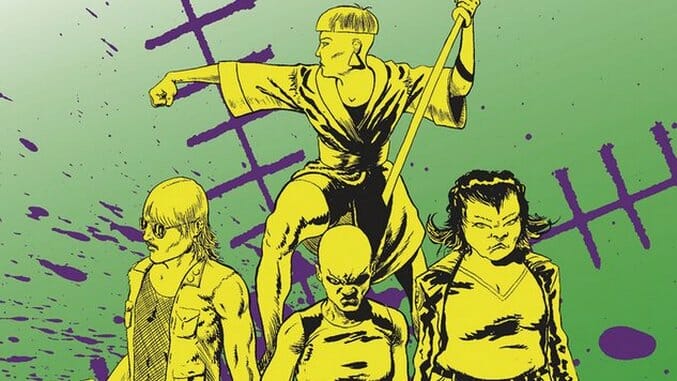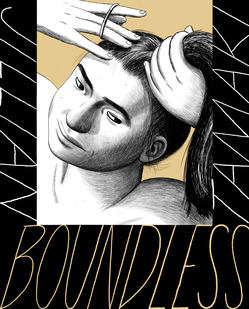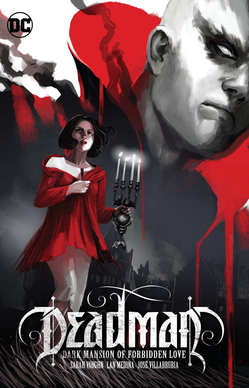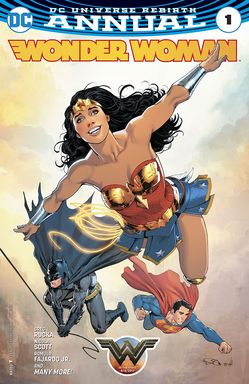
We hope you’re enjoying (or, depending on when you’re reading this, enjoyed) your Memorial Day on a beach, in a park or otherwise far away from an office—and bonus points if comic books play a part in your day-off strategy. This Wednesday offers a spectrum of choices from the Wonder Woman Annual, timed perfectly for Amazonians who just can’t wait for the Gal Gadot film hitting theaters this weekend, to Boundless, Jillian Tamaki’s latest collection of indie-cool comic shorts. Marvel hits peak ‘90s with a Cable relaunch that emphasizes the future fighter’s big-ass guns, and frequent Marvel contributor Dustin Weaver strikes out on his own with Paklis, a solo anthology for Image that promises to show off the full breadth of his interests and massive talent. And if you’re looking to tune in and drop out, the first gyro-laden collection of Gerard Way, Nick Derington and Tamra Bonvillain’s mind-expanding Doom Patrol hits stands for your trip-out pleasure.
 Aliens: Dead Orbit #2
Aliens: Dead Orbit #2
Writer/Artist: James Stokoe
Publisher: Dark Horse Comics
Anyone disappointed by Alien: Covenant’s philosophical posturing and lukewarm action, fret not: the claustrophobic dread of Ridley Scott’s 1979 game-changing film beats deeply in the panels of Dead Orbit. Writer/artist James Stokoe adorns his pages with a dizzying amount of detail; space debris orbits hulking ships covered in entropy, like ancient monuments viewed through an ‘80s manga sci-fi filter. The hugeness of the dead, uncaring universe contrasts with the intimate journey of protagonist Wascylewski, an engineer stranded onboard the Atol Sphacteria. Stokoe flips between past and present to show how “Wassy” became marooned alongside the iconic H. R. Giger-designed genitalia monster, and it is scary as hell. The cover for this sophomore issue hints at what calamity may have ensued. Dead Orbit has the rare ability to present an engulfing aura of doom in a few pages, with characterization built around regret and good intentions that unintentionally invites chaos. No artist can explore the textures between metal and flesh as capably as Stokoe, enbodying the uncomfortable themes of horrific reproductivity that lie at the heart of this franchise. Sean Edgar
 Boundless
Boundless
Writer/Artist: Jillian Tamaki
Publisher: Drawn & Quarterly
Jillian Tamaki is a treasure of storytelling. Her webcomic about awkward teens prodding the boundaries of their futures and authority—SuperMutant Magic Academy —could invite tears and reveal biographies of personality in a few panels. Her new collection, Boundless, pulls from her contributions to Youth in Decline’s stellar Frontier series as well as from indie publishers Nobrow and Hazlitt.net. Together, their themes meld surprisingly well into one body of work; technology, identity, loneliness and perception lie at the heart of these vignettes. Marquee story “Jenny” manages to blend all of them into the introspective tale of a girl who discovers a social networking site that depicts a more “perfect” version of herself. Each entry also exercises the sheer breadth of Tamaki’s style, from heavy shadows to fuzzy, blue-tinged portraits as the cartoonist welds a daring range of aesthetic and line. A glorious base of I-don’t-give-a-fuck honesty lies at the heart of Tamaki’s work; it pokes at the human condition and produces some of the most thoughtful comics of this generation or any other. Sean Edgar
 Cable #1
Cable #1
Writer: James Robinson
Artist: Carlos Pacheco
Publisher: Marvel Comics
For all of the mockery hurled at Marvel’s ‘90s creations, characters like Cable and (obviously) Deadpool have enjoyed multiple long runs and plenty of standout stories. Cable, the metal-armed future son of Cyclops and Madelyne Pryor, was left in a weird spot following his last run with X-Force, and last popped up in the pages of Uncanny Avengers alongside his frequent buddy, Wade Wilson. Now the big dude is back in a time-hopping solo series from writer James Robinson and artist Carlos Pacheco. Pacheco’s clean, classic linework emphasizes the glorious ridiculousness of muscle-bound Cable without veering into full-blown ‘90s parody, while Robinson’s throwback approach to dialogue—which often grates on books like Squadron Supreme—should fit nicely with the teeth-gritting cyborg soldier. Marvel’s latest X-family of books doesn’t look like it’s going to hit the heights of past runs, but is at least some comfort to fans eager to see the spotlight turned away from the Inhumans and back toward the mutants we all know and love, time-travelers included. Steve Foxe
 Deadman: Dark Mansion of Forbidden Love TPB
Deadman: Dark Mansion of Forbidden Love TPB
Writer: Sarah Vaughn
Artist: Lan Medina
Publisher: DC Comics
Ghostly circus performer Boston Brand is a b-list favorite of DC fans and floated around the New 52 era quite a bit, largely in Justice League Dark. Recent prestige-format mini-series Deadman: Dark Mansion of Forbidden Love put the spectral acrobat’s talents to use in ways that would make early Vertigo readers proud, serving as a player in a full-blown—and fully inclusive—gothic romance. Writer Sarah Vaughn nimbly and timelessly twists the genre away from some of its worrisome tropes to offer a faithful yet honest version of the gothic subgenre, while artist Lan Medina’s work, buoyed by José Villarrubia’s expert colors, earns every bit of the “prestige” label. Dark Mansion of Forbidden Love is a boon to fans of Sandman and other dark literary fantasy tales that sadly seem to have fallen out of favor lately, and is hopefully only the first step in DC’s further experimentation with genre and format. Steve Foxe
 Doom Patrol Vol. 1: Brick by Brick
Doom Patrol Vol. 1: Brick by Brick
Writer: Gerard Way
Artist: Nick Derington
Publisher: Young Animal/ DC Comics
In a not-altogether-surprising turn of events, it took Young Animal architect Gerard Way and illustration sensation Nick Derington a bit longer than anticipated to wrap the first arc of their psychedelic Doom Patrol reinvention, although fans of the franchise will be hard pressed to argue that initial arc “Brick by Brick” wasn’t worth the wait. Way and Derington, with ample assistance from colorist Tamra Bonvillain, distill the gonzo appeal of Grant Morrison and Richard Case’s storied run—as well as Rachel Pollack and co’s oft-overlooked follow-up—with genuinely new ideas, a feat that’s rarer than it should be in the modern comic climate. During an era of reboots eager to trash previous continuities, Way, Derington and Bonvillain folded years of reality-jettisoning storytelling into a fresh story of an EMT in over her head, and a gyro that’s more than just tasty street food. It may be a while before we see Doom Patrol Vol. 2, but every long-awaited issue proves the vital need for Young Animal’s thesis statement: Comics for Dangerous Humans. Steve Foxe
 Joe Golem: Occult Detective: The Outer Dark #1
Joe Golem: Occult Detective: The Outer Dark #1
Writers: Mike Mignola, Christopher Golden
Artist: Patric Reynolds
Publisher: Dark Horse Comics
The Mignolaverse—comics spawned from Hellboy creator Mike Mignola—has remained a rare safe haven for genres that haven’t thrived for decades. Publishers EC and Warren specialized in occult, crime and horror fare into the early ‘80s, fighting through industry red tape including the Comics Code Authority. That storytelling DNA still winds through Joe Golem, B.P.R.D., Baltimore and Witchfinder, comics in perpetual love with the occult and eerie. Joe Golem: Occult Detective holds the honor of harboring two genres within its panels, thrusting its hapless PI into a world of horror and noir. This new miniseries from writers Mignola and Christopher Golden and artist Patric Reynolds pits the titular gumshoe against a strongman directed by ominous voices. Each miniseries has excavated deeper into Joe’s backstory (the “Golem” surname isn’t just hyperbole), while offering accessible, sleek arcs perfect for newcomers. The Outer Dark promises another journey into a Raymond Chandler-meets-Bram-Stoker world of grizzled crime and things that go bump in the night, and it is enjoyable on every level. Sean Edgar
 Paklis #1
Paklis #1
Writer/Artist: Dustin Weaver
Publisher: Image Comics
Dustin Weaver , the singular talent behind Marvel joints from S.H.I.E.L.D. to Secret Wars: Infinity Gauntlet, strikes out on his own in an unusual fashion: a solo sci-fi anthology. Paklis, Weaver’s first major Image work, sees the Marvel staple writing and drawing three serial tales on his own. The book kicks off with “Mushroom Bodies,” featuring a world of human insects; “Sagittarius A*,” in which a war hero chases his dead father’s dark experiments; and “Amnia,” named for a prophetic alien who inspires a starfighter pilot to go rogue. Weaver dabbled in scripting while at Marvel, and Paklis will give his fans a trifold opportunity to see what he can do when he’s unchained from corporate intellectual property. Weaver’s intricately detailed pages and fine lines are a rare treat in with breakneck world of mainstream publishing, and will be all the more appreciated when allowed to flourish independently in a host of sci-fi tales. Steve Foxe
 Revenger & The Fog
Revenger & The Fog
Writer/Artist: Charles Forsman
Publisher: Bergen Street Press
Like his contemporaries Benjamin Marra and Michel Fiffe, Charles Forsman is interested in fuck-you-I’ll-do-it-myself comics: grungy, perfectly imperfect solo works that bear his mark from top to bottom. Revenger is pure grindhouse revenge, an anti-hero with a vendetta and the bullets to back it up. In this follow-up volume, Forsman’s determined protagonist meets another ‘70s/‘80s trash-cinema trope—a teen street gang of rough-and-tumble survivors known as The Fog. One of the members is kidnapped by her sleazy, incestuous father and ample retaliatory violence follows. The other component of this trade collection is Revenger is Trapped, an escape jaunt that begins exactly as the title promises. Forsman’s work is lean and mean, with an accomplished simplicity of line and evocative color work. You’re not going to see this guy taking over Punisher any time soon, so if you’ve got the stomach for grime, Revenger & The Fog is pure, undistilled Forsman ready to hyper-violence all over you. Steve Foxe
 Saga #43
Saga #43
Writer: Brian K. Vaughan
Artist: Fiona Staples
Publisher: Image Comics
If Saga’s previous 42 issues have confirmed anything, it’s that writer Brian K. Vaughan and artist Fiona Staples are in this for the (very) long haul. At the end of this winding expedition of family, loyalty, sex and bananas sci-fi, grad students will write their thesis on this landmark comic and upcoming writers will avoid the genre, woefully lamenting I’m not touching that shit after Saga. The first act witnessed two star-crossed alien lovers give birth to a hybrid baby, united in an us-against-the-universe struggle as two amoral armies pursued them. The second act showed how the greatest battles—drug addiction, infidelity and doubt—can emerge in the most peaceful lulls. The third (each consists of 18 issues, collected in hardback books) is only six issues in, but struck a massive, personal blow against parent heroes Alana and Marko in the last issue. Issue #43 is a fantastic jumping-on point, priced at $0.25, introducing a new story arc. The solicitation copy doesn’t reveal much, aside from “a new adventure at the westernmost edge of universe.” The cover, featuring Alana mounted on a multi-colored zebra à la Fruit Stripe chewing gum, lends itself to a psychedelic western, but we’re equally curious about the psychological lassos that remain. The creative team hasn’t stopped melding sucker-punch creativity with gut-wrenching drama, and not one issue has failed to warrant our endorsement. Sean Edgar
 Wonder Woman Annual #1
Wonder Woman Annual #1
Writers: Vita Ayala, Collin Kelly, Jackson Lanzing, Michael Moreci, Greg Rucka
Artists: Stephanie Hans, David Lafuente, Claire Roe, Nicola Scott
Publisher: DC Comics
To dovetail with Wonder Woman’s film debut this Friday, DC is offering this annual filled with a cache of stellar writers and artists articulating the Amazon princess’ decades-long appeal. The issue also serves as a semi-swan song for Greg Rucka, whose fantastic tenure on the comic ends with next month’s 25th issue. His story with Nicola Scott, who also collaborated with him on the series proper, introduces Wonder Woman to Batman and Superman for the first time in DC’s new continuity. Much like Grant Morrison in his Earth One graphic novel with Yanick Paquette, Rucka embraced the foundation set for the character by creator William Moulton Marston—i.e., Wonder Woman likes girls and a society founded by women would be a peaceful Utopia. This last weekend hasn’t disproven that thesis. Michael Moreci also provides a supernatural slant on the character with artist Stephanie Hans, whose dreamy paints on Angela and Batman make her a perfect guide to a land of gods and curses. Sean Edgar